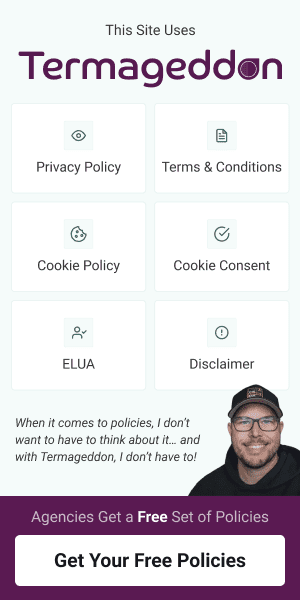Simply put, I wish The Admin Bar was around while I was running my agency. It has been fantastic to connect with fellow agency owners and provide each other with insights and best practices. The Standard Operating Procedure that I have provided below is a collection of processes and questions I personally developed and used with my web agency team. I hope this provides you with insights and perspectives that help you run a more profitable business with happier customers!
1.0 Document Overview
The goal of this document is to provide web agencies owners a sense of how I use to charge my clients for the Discovery phase process (back when I was running my 12 person web agency). I’ve come to appreciate the Discovery phase and in many ways consider it to be the most important phase in the web design process.
Disclaimer
This document should not be considered the answer to all of life’s problems. I’m passionate about this topic, but that doesn’t mean there are perfectly fantastic alternative solutions to addressing the Discovery phase. Remember, I ran an agency in a silo; I did not have peers to bounce ideas off of. Had I been a TAB member in 2012, I may have started earlier in my career focused on value based sales (see post by Kyle), and that would have led to many other great solutions as well. This is a long winded message to simply state that there are many ways to go about solving challenges within web design. This document outlines how I personally solved the challenge for me, and I hope you get some solid takeaways to improve your operational efficiency, increase client satisfaction, and get paid for your time!
Why read this document?
Three reasons.
- You will get paid more
- Consulting is something I gave away for free for years because I didn’t understand the value of Discovery.
- You will reduce the risk of scope creep
- This project catches ‘out of scope’ requests with ease. Best of all, the client will understand when they have out of scope suggestions!
- Red flags naturally get weeded out
- If people don’t want to pay for your consulting (aka Discovery) services, then they don’t respect your business enough to work with them.
Already overwhelmed?
This outlook I have on Discovery may look intense, but I strongly believe that agencies are performing everything I discuss below, whether or not they are getting paid for it. The turning point for me and my agency was when I finally realized “Hey I’m doing a lot more for my clients than they even know. It’s important they understand what goes into the websites I build and I should be compensated for this!” <<< Seems simple enough, but the fact is that there is a LOT that goes into building a great website!
Your fees will increase, but your risk will lower
This article is undoubtedly set up to help you make more money within the Discovery phase. This is because most agency owners do not realize they put a lot more time into this part of the project, whether upfront (like I recommend) or later on in the project (when it becomes more expensive because you have more iterations).
Pitching Discovery: Not cheapest, but also not the riskiest
Let’s create a blueprint of your house first.
If you are not charging for Discovery currently, I will just about guarantee that your pricing will increase if you implement the steps below. That may be good for you, but your future clients may be surprised when they receive your quote.
You can address client concerns with a simple fact: your objective is to build websites on time and within budget. You want to develop (and charge for) a blueprint before any design or development work starts. This means an upfront cost, but it also means way less risk in the future of something going wrong. You may not be the cheapest web design service provider out there, but you also are able to clearly communicate exactly what each part of the web design process will cost. In other words, your focus is on risk management; ensuring the project moves along the process as smoothly as possible.
Prospects coming to you that have been burned in the past will often find this messaging relieving and will be more inclined to work with you!
Clients too small?
If you are sitting here, thinking ‘my clients are too small for this level of service’, then my return question is “are you targeting the right market?”. The fact is, if a prospect goes through this level of preliminary questions and also respects your Discovery phase, you have just about solidified the fact that this client respects the insights and opinions of third party service providers, which can be a huge way to remove red flags from your own pipeline. Something to consider!
I found myself branding my agency as ‘on time, within budget’. This messaging aligns with this fairly extensive Discovery phase, and it naturally selects clients that have gone through the pains of poor web development experiences.
What I can definitely say is for the projects that were $20k+, we had no issue at all having clients pay for Discovery. Motorola, for example, was a six figure per year client that expected this level of care (it took 5+ years to close accounts like Motorola).
Even if you don’t implement this method into your business operations, there is still one clear takeaway from this document: reduce project scope creep by getting answers upfront rather than after you started coding.
Record your calls (with permission of course)
Some secret sauce: record calls with your prospects.
With permission, record calls with prospects sharing their vision for a new website. Then take notes after listening to the call recording. This allows you to pause, take notes, and reflect on their objectives. Yes it takes more time, but it is astonishing just how much prospects appreciate how diligent you are at understanding what they are trying to achieve.
Recording calls is extremely valuable because:
You can reiterate everything they are seeking in their new website, basically verbatim. People like to know that they’ve been heard. This does very well with converting prospects to clients.
You pick up on things you didn’t originally fully comprehend when first talking with them
As painful as it may be, you listen to yourself communicating with the client. This will give you the ability to constantly improve your own personal communication skills.
Define your Discovery Deliverables, then work backwards
Whether you choose to use the Discovery Deliverables below or create your own version, it is important to note that you should first start there before defining your sales process (and preliminary questions to see if they’re a good fit).
2.0 Phases
Below are the phases I had for a website project.
01 Sales
Identify client objectives, what they have (ie content or imagery), and their budget. Your objective here is to complete the ‘pre discovery document’ so that you can generate a quote for the discovery phase.
02 Discovery
This is where you identify all aspects of the website. From user flows to sitemap to content to seo to image sources to functionality, you want to define as much as you possibly can to reduce any unknowns when moving into additional phases. This is also a good time to have a ‘future upgrades’ bucket to identify things to quote after you launch initial website.
03 Design
Providing mockups. Do not move forward until mockups are signed off. Not discussed in this document.
04 Development
Developing website. Not discussed in this document.
05 Deployment
Deploying website to live server. Not discussed in this document.
06 Digest (internal)
If you have a team, take time to discuss the ups and downs of the project. What can you do to improve your SOPs so that future clients have an even better experience. Not discussed in this document but a critical component to constant improvement. If you don’t have a team, set aside an hour in your calendar to decompress on a project and figure out how you can improve your SOPs for the next project.
07 Ongoing
WOM so hard. Wish I had this when running my agency! Not discussed in this document.
2.1 Sales Phase – Find great fits. Remove red flags.
Before jumping into the Discovery phase, it’s important to note what you (and your client) will be bringing to kickstart the Discovery phase. I would call it a ‘Pre-discovery doc’, meaning a document that you fill out and complete to provide a quote to perform the Discovery phase.
Yes, I believe charging for only Discovery is appropriate for most (not all) websites, and because this is probably a major new concept for readers, I am going to assume this flow for the remainder of this document so that there’s no confusion.
Why only charge for Discovery?
Have you ever found yourself working on a project and right before site launch the client asks you about SEO even though they’ve never brought up SEO as a goal? How about when clients all of a sudden have a rogue subdomain with a whole bunch of other features they thought was included in your original post? Or the client asks something like ‘where do my distributors go?” when you had no idea that the website was even intended to be usable for distributors?
These are just a few examples of how easy it is for a client to be disconnected from a web agency owner when it comes to a new website project. Having a formalized Discovery process can massively reduce these risks from popping up.
You are charging for Discovery to manage risk for a project. You are preventing scope creep.
Why would a client only pay for Discovery?
Deliverables. You need to showcase what the deliverables of the Discovery phase are. We discuss this later, but high level, you are providing a blueprint for a project. Who builds a skyscraper without a blueprint? Or a house for that matter? Or even a shed? If you are building a campsite, then sure a blueprint isn’t needed. But if your building something more long term, you need to make sure as many questions are answered as possible before proceeding into additional parts of the project.
Sales questionnaire – AKA Pre-Discovery SOP
The goal of your sales questionnaire is to understand roles and responsibilities of the Discovery phase and to give you an understanding of what it will take (cost) to provide the Deliverables at the end of the discovery phase.
Keep in mind: It’s been over 2 years since I sold my agency and everything below is from memory.
Categories:
Objective
- What is your objective with this new website? Why do you want a new website?
- What does your business offer?
- How do you plan to drive traffic to your website
Users/Stakeholders
- Who are the stakeholders for this project? (prospects, customers, investors, employees, managers, marketers (internal and/or external, IT dept, deptartments).
- Who is your target audience? Do you have some close customers I could call to ask their opinion on what they look for in a vendor like yours?
- Are you open to me contacting companies that you target to ask them for insight into what they look for in a vendor like you?
- Interviewing prospective companies/individuals to provide insights into what they look for in a vendor speaks volumes to prospects. They quickly realize just how comprehensive your efforts are! On top of that, by having user flows, you help the client rely less on their subjective ‘feelings’ about a new website, and can leverage the user flows as what prospects want to see (not necessarily the website owner).
- Are you the type of person where you want to make the final decision on the look/feel of the website, or are you more open to letting customers and prospects define what they instead want to see?
- What do they want to see from this website?
- Who is a typical customer?
- Do you need to user experiences beyond website prospects? Perhaps distributor pages? Or a portal of any kind for employees, vendors, etc?
- Do you target individual consumers or businesses or bothWhat do people search to find your website
- How will your staff utilize the website? Do they need to make updates to it in the future or are you looking for a vendor like me to supply these updates?
Functionalities
- Do you need contact forms
- General? Employee application? Newsletter? Donation? Purchase?
- Ecommerce
- (There’s a whole list of other questions here… if there’s enough interest I can add questions to this)
- Be sure to address/define default emails in the discovery phase. Also, user flows for admins facilitating the online sales (shipping confirmations). Also, taxes.
- Login portal for customers, employees, vendors, distributors or anyone else?
- Analytics? Security? (if this is something you offer by default, you can allude to some of the ways you address this by default).
- Do you have an existing analytics account I can review?
SEO
- Does your website currently rank in search engines? Are you able to issue me access to your analytics account?
- Is search engine exposure a goal for this project?
Copy/Media
- Do you know what pages you want developed?
- How many services do you provide (or products do you sell)
- Do you plan to provide content or are you looking to have a contractor provide this?
- Do you have branding guidelines?
- Who’s responsible for imagery? Content? If the client is going to take this on, is it already developed?
Budget
- Have you established a budget for this project?
Miscellaneous
- Do you have any subdomains we need to know about?
- Who do you currently host with? Does the new website need to be hosted anywhere specifically
- Do you have any competitors? Please provide URLs
- Are you inspired by any websites? Please provide URLs
- How many locations do you have
- Have you worked with a web developer in the past? What went right? What went wrong?
- We would like one point of contact who will provide feedback on behalf of the company. Is this okay with you?
- (questions regarding your preferred communication methods and if they are okay with that)
- (Explain your process, and how you charge for Discovery to start. Explain how at the end of Discovery, the client will receive a quote for the remainder of their project but they are also welcome to take this Discovery document and shop it with other web designers. In fact, you should encourage that they do this! This builds trust).
- Is there anything I should know about that I haven’t asked?
- Can we share your project publicly as a project we worked on and to what capacity?
- Current website: what do you like/dislike about it?
Quoting Discovery
Understand your Discovery deliverables and work backwards. What will get you to the point where you can provide the final deliverables? Do you need to hire contractors? Interview customers of the client? Define all pages?
Remember: your job is to reduce the risk from going out of scope/budget. Do all you can to give your project the best chance possible of success.
Upon getting all your sales questions answered, you should be in a position to provide a quote for the Discovery Phase. Find the parts of the project that they don’t have answers for, and provide a quote to get that answered for them. Be prepared to bring in contractors for ‘stuff you don’t do’, like copywriting, media production (photos, videos), SEO, extensive functionalities, etc.
As time goes on, you’ll be able to get a good idea of what each part of a project costs in terms of your time commitment as it relates to Discovery. By not designing nor developing, you are reducing risk for yourself and your client, saving yourself from making assumptions that lead to wasted time.
Also, there are some basics to any website project, setting up your tech stack, installing themes, plugins, etc, and making sure you’re paid for scheduled meetings (Kickoff call, content review, etc).
I found the most success defining all pages (or at least an idea of number of pages) before going into Discovery.
2.2 Discovery Phase
Client signed contract to only do Discovery. Fantastic! You’ve helped manage project risk. Now, your objective is straightforward: provide the deliverables of the Discovery phase to the client (along with a quote to execute the design/development/deployment phases).
I personally worked towards completing these deliverables by:
- Establishing a kickoff meeting where deadlines, scheduled calls, and potential challenges were identified.
- Utilizing a sitemap software and worked on getting signoff on a per page basis
- Each page within the sitemap software would include content, imagery, functionalities.
This phase will consist of you getting a lot of ‘stuff’ from your client, as well as through vendors for stuff like copy, functionality needs, etc.
Discovery Deliverables
This is what customers pay for when purchasing Discovery from you. This should be a
- Current website
- Issues/challenges
- Project overview
- Website objective
- User personas, flows and objectives
- Define how users will arrive on the website, how users will interact with the website (information they need to see before inquiring or performing desired action), and primary objectives of each user type. Be sure to address not only website visitors (prospects), but also define user experience of marketers for example who will need to go into the backend of the website and post blogs, etc.
- If you interviewed prospects, show the resulting data.
- Website global features & functionalities
- General functionalities (wordpress, google analytics, etc)
- Sitemap
- Content
- Imagery
- Page specific Functionalities
- Design inspiration
- License purchases
- All third party licenses that will need to be purchased to complete this project (themes, plugins, etc).
- Future addons
- Define all future opportunities to improve the project after initial launch. These can be projects you quote in the future for clients.
- Design, Development and Deployment Quote
- Detailed quote to perform the remaining phases for the project.
- Deployment phase can sometimes include training staff on how to utilize the website; be sure to address this.
- Deliverables for respective phases.
- Detailed quote to perform the remaining phases for the project.
Signoff
Client must sign off that the Discovery phase is completed before the Design phase can begin. This allows both you and the client to come back to this document in case either party goes out of scope later on. After Discovery signoff, all new ideas will be added to the ‘future addons’ document.
3.0 Conclusion
I am not the first and I certainly will not be the last to say this: there is a lot to go into building a website. The final product of a newly launched website is truly a ‘tip of the iceberg’ when compared to just how much time and effort went into all aspects of the project itself.
What you can control as an experienced agency owner is the potential risk of scope creep, and having a comprehensive Discovery phase can be the primary phase the manage scope to the best of your ability.
4.0 Anti-Discovery Concept
I also want to note that I was tinkering around with a ‘same day website’ program, where I charged $2900 and built a website for the client in a single day. In many ways, SameDayDev was the opposite to this hardcore sales/discovery program in that we were volume focused and worked with smaller clients with smaller budgets. This was right at the end of my career as an agency owner, and it showed tremendous potential. I think I did about a dozen of these “Same day websites” and the results were very promising.
With same day websites:
- Client has a clear understanding that ‘today is the day’ to put in all your requests. It is incredible how much they appreciate your time and the hours set aside for a project. It literally whipped clients into shape because they understood (and respected) the process.
- After a hard days work, you’re done! You can go home, feeling accomplished and not having to stress about a deadline.
- High volume, but 4 same day dev’s per month equals about $12,000/month in revenue (not to mention maintenance revenue).
- Great way to get a project done and right into an ongoing maintenance plan.
Recommended Reading:
Wondering how to explain to your client why you charge for discovery? Here’s a great article on that very subject from UGurus







